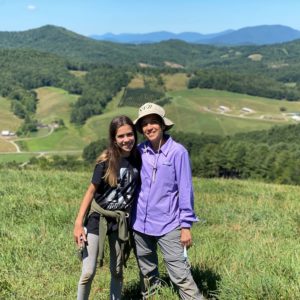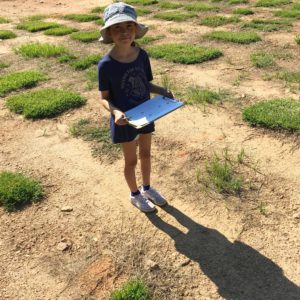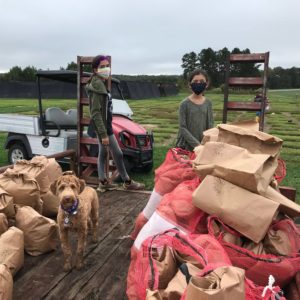
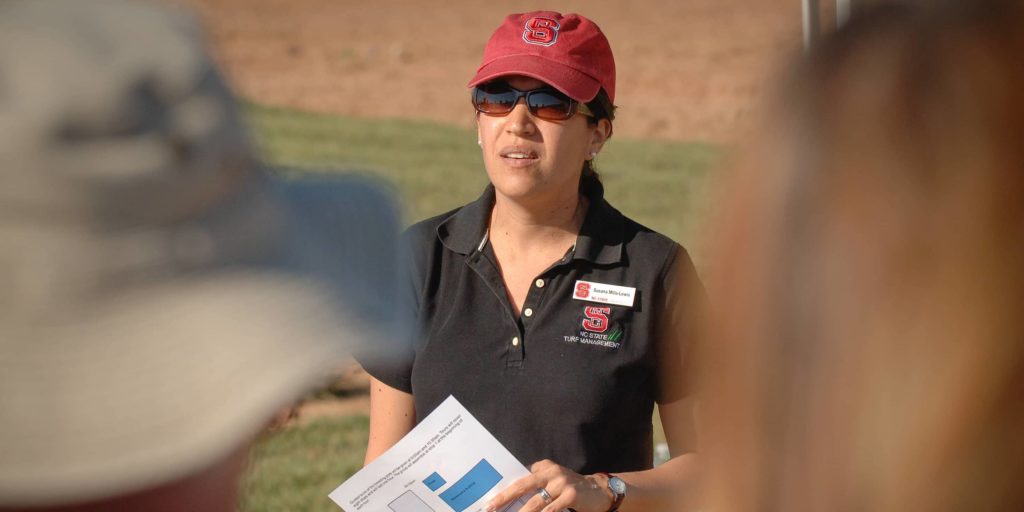
From Peru to North Carolina State University: The Journey of Dr. Susana Milla-Lewis
Dr. Susana Milla-Lewis, a professor and university faculty scholar of turfgrass breeding at North Carolina State University (NCSU) has a very impressive and interesting life story. Born and raised in Lima, the capital of Peru, she now runs one of the best up-and-coming turfgrass programs in the nation.
Her attention to nature and green space started at a young age and has only grown. Milla-Lewis remembers as a kid, Lima was a big city where it didn’t rain very often. “So, it’s kind of gray and the only places where you have great green spaces are in public parks. It’s not like North Carolina where everything is green,” she said.
Moving to the United States was in the cards for Milla-Lewis for some time. Her two older brothers had both moved to the U.S. for graduate school. Her oldest brother, Carlos, is an MD Ph.D. currently at Stanford. Her second brother, Marcos, who she says has always had a huge influence on her life, is a biochemist. “They both came to the U.S. pursuing higher education so I kind of had that model to follow.”
She recalls being 12 years old when Marcos left Peru to get his Ph.D. and deciding she wanted to go to the U.S. too to get a Master’s and Ph.D. degrees. With this goal in mind, she finished her undergraduate degree in four years rather than the normal five years it takes in Peru. After graduation, she did a research internship at the International Potato Center, an organization that has research centers distributed around the world. “I knew if I did an internship there that those references were going to weigh more towards my graduate applications,” she explained.
After that, she applied to get into the master’s program at NC State and was accepted. It was officially her time to leave Peru. In 1996, she packed her entire life into two suitcases to move to the United States. She packed her most meaningful trinkets and even the rug from her bedroom into those two bags. “Don’t ask me how I fit it into my suitcase but I did,” she laughed.
She remembers the farewell from her family at the airport being very sad. As she passed through the security gate crying she thought to herself that she couldn’t mope around because leaving for the US to get her graduate degree was a long-held dream. So, although she was sad to leave her family she made herself focus on the great opportunities that lay ahead for her at NC State.
“I’m not gonna lie. I missed my family, my friends, the food and so many things but this was the dream that I had pursued and that was coming true. I made a mental promise with myself that I was going to push forward,” she said.
New to the Wolfpack
Upon arriving at NCSU, she started to pursue her Master’s Degree in Tobacco Breeding and graduated in 1998. Then in 2003, she earned her Ph.D. in Peanut Breeding from NCSU. Milla-Lewis worked in this field for about five years before delving into building a new turfgrass breeding program at NCSU.
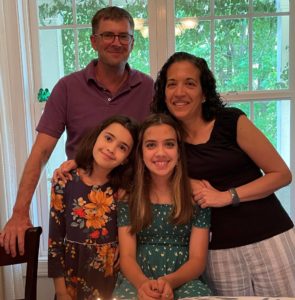
Dr. Susana Milla-Lewis with her husband Ramsey Lewis and their daughters Sienna and Adrianna in May 2021.
When NC State opened a position in turfgrass breeding in 2008, they were looking for someone who could build a program from the ground up. “Initially I looked at it and said I don’t really know anything about turfgrass.” But the chair of the search committee for this role encouraged Milla-Lewis to apply given her vast knowledge and experience in breeding and molecular work, explaining she could just apply that to a new species.
At the time she applied, her husband, Dr. Ramsey Lewis, was an assistant professor at NC State. They began having conversations about what it’d be like for them both to be assistant professors if she got the job. Milla-Lewis said not only did she have to consider the tenure process she’d have to undergo as a new professor, but her daughter was also only a year and a half old at the time. She and her husband spent some time debating how they would manage family life while both working at the university and decided they should go for it.
But, Milla-Lewis said she still didn’t know much about turfgrass so she started doing her homework. “I spent two months talking to anybody who would talk to me. I talked to a lot of turf faculty, called industry breeders out west, went to visit sod farms, and I drove out east to meet with our extension specialist there. My main goal was to try to learn more about the turfgrass industry but also to find out the niches or needs that weren’t being met and find where a breeding program could fit in the big scheme of things. I really did my homework and I got the job and the rest is history,” she said.
Milla-Lewis started in the program as the Assistant Professor in Turfgrass Breeding and Genetics. Now, she and Ramsey have two daughters, Sienna who is 14 and Adrianna who is 10.
Turfgrass Career
Milla-Lewis had worked in tobacco and peanut breeding programs where the focus was just one species. When she went to work in turfgrass. “I remember early on one of my grad students joked that most of the breeders on campus were doctors but I was a vet because I’d worked with all of these different species.”
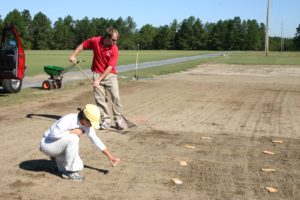
Seeding NCSU’s first fescue nursery at Sandhills in October 2009.
She said she loves working with multiple turfgrass species as there is never a dull moment, they are always working on something new. Since they work with warm and cool-season grasses, her program stays busy year-round. One day they’re seeding a new trial and the next they’re putting grass to sleep and there is always something going on at the greenhouse or in growth chambers.
“I love that. It’s very fun that you can come up with all these different projects in a variety of species. You don’t have to think too hard about what you want to research – there’s always something.”
Milla-Lewis describes her research as trying to develop varieties of grasses that are better adapted to specific conditions in North Carolina. “We look at hundreds of new grasses, throw as many environmental stresses as possible at them, and then select those that survive better. Ultimately, the goal is to develop grasses that perform better with lower inputs so that they are easier and cheaper to grow for both producers and consumers.”
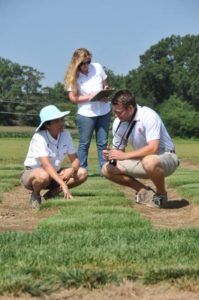
Milla-Lewis (left) with graduate students Jenny Kimball (currently an assistant professor in wild rice breeding at University of Minnesota) and Jeff Dunne (Currently an assistant professor in peanut breeding at NC State) at the 2014 NCSU Field Day.
Her position at NC State is 85% research and 15% teaching. She teaches the undergraduate Plant Genetics course every spring, which is designed primarily for agronomy and horticultural science students. She leads the breeding program while teaching this course, and for the remainder of the year she is only focused on research.
The busiest time of the year is typically as the spring semester ends and Milla-Lewis has to determine what research trials they’re going to plant. “Planting season is crazy busy, but it is the most exciting time of the year. You get to put new grasses on the ground and see how they perform. The excitement of identifying a new promising line or seeing one of your favorite lines outperforming standard cultivars is hard to describe.”
Milla-Lewis said in a given week she could spend one day in her office, the next attending a seminar about research ethics, the following in the mountains planting roadside trials and the next in a meeting with other plant breeders. She thrives over the fact that no two days are the same in her role at NCSU. “The day-to-day of a breeding program is varied depending on what month it is. We go from the field, to the greenhouse, to lab work, to data analysis. Plant breeding encompasses many different aspects. When I recruit students or talk to people about plant breeding, I tell them that variety is what I love the most about my job.”
Overcoming Cancer
Nearly eight years ago, in her third year at the turfgrass program, Milla-Lewis was diagnosed with breast cancer. Now, in remission and taking on her life to the utmost fullest, she shared what that experience was like.
“Everything is good now but a cancer diagnosis is not something you leave behind, you live with that for the rest of your life because you’re always thinking it could come back,” she said.
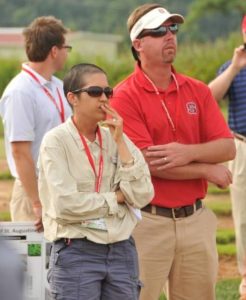
Dr. Milla-Lewis at the 2013 NCSU Field Day during her battle with cancer.
Milla-Lewis explained cancer taught her that she will never know what is going to happen next, but she can reflect on the fact she’s fortunate to have had the last seven and a half years. “When I was diagnosed, my youngest daughter was a year and a half old and it was really hard to think that she might not get to know her mom. And that’s one of the things I always think about now. I have had the last seven and a half years with her and she knows me. No matter what, she knows me and that’s good. I’m very thankful for that.”
She recalled when she was first diagnosed and realized how bad the cancer was, the nurse started explaining all of her appointments she’d need to schedule, from scans to getting a port put in, etc. Milla-Lewis reached in her purse for her cell phone and said let me check my calendar. But the nurse took her phone away and told her nothing else mattered anymore. “I had an epiphany. That moment has given me more perspective in life than you would ever imagine. I used to be a panicky person running from one thing to another and I learned at that moment that nothing is that important. Anytime I panic about missing something nowadays, I say, ‘you know what? It’s okay. The world will continue turning if you cannot go or if you have to reschedule or if you miss something. It’s okay.’”
Environmental Stewardship
Over the past few years, one of the things Milla-Lewis has witnessed change is the environmental stewardship associated with turfgrasses. When she started interviewing and learning about the industry more in 2008 she realized this for the first time. She drove around Raleigh through subdivisions and observed what grass species were in different yards and observed a lot of cool-season grasses, primarily tall fescue. But as she started in the program and began researching warm-season grasses, several people questioned what exactly she was thinking. Her explanation was that weather and climates are changing dramatically.

Pictured above is a graph Milla-Lewis regularly shares in presentations. It shows the estimated number of days in a year that will exceed 90 degrees Fahrenheit. In summary, the chart shows that leading up to 2080, nearly 120 days of the year will be over 90 degrees.
“So, if the temperatures are changing, it’s going to be hotter and it’s going to be drier, then we need to be more conscious about what grasses we promote for specific areas. For example, for big cities in central North Carolina, warm-season grasses, with their lower water requirements, will be a more environmentally conscious choice.”
While there will always be a group of people that want a highly manicured lawn, she said more of the market has become content with a lawn that looks good but doesn’t have to be absolutely perfect because they want fewer inputs and less maintenance. She thinks that the market for a low-input lawn will continue to grow.
In the research realm, she’s working more on drought-tolerant varieties that require less water to stay alive. “Water is only going to become more scarce and is going to be a very sought-after commodity. So we as an industry need to start focusing more on grasses that use less water.”
New Cultivars and Collaborations
Milla-Lewis shared that although there already are many commercially available grasses on the market today, the environment keeps changing and we have to react to it. “Temperatures are going up, we’re having more droughts in different areas and we’re having more unstable winters with temperatures going up and down which kills grasses. Also, the customer is changing. The new generations are looking at property and lawns in new ways. Cities are growing and developing differently.”
She explained as the turfgrass industry adapts to new needs that are popping up, they have to develop turfgrasses that will better suit those needs.
When it comes to collaborations, Milla-Lewis says she’s very proud to be a part of the warm-season turfgrass Specialty Crops Research Initiative (SCRI), funded by the United States Department of Agriculture. The project includes the breeders at five different universities: herself at NC State, Kevin Kenworthy at the University of Florida, Brian Schwartz and Paul Raymer at The University of Georgia, Yanqi Wu at Oklahoma State University, and Ambika Chandra at Texas AgriLife System. The project aims to develop drought-tolerant turfgrass cultivars for the southern US by testing the best lines of each program across all these states.
Milla-Lewis explained since the initiative started in 2010, she’s been so impressed with the team approach to breeding drought-tolerant turfgrasses. “Ultimately this concept where we all evaluate everybody else’s germplasm in multiple locations benefits the entire industry because we are testing materials across a wide range of environmental stresses. The top-performing lines are true champions that can thrive not matter what you throw at them. Furthermore, we might have more regional deployment or marketing for a grass, which can be really good.”
Lobo™ Zoysiagrass
After years of research and hard work, Milla-Lewis announced the name of NSCU’s new low-input, low-maintenance zoysiagrass release on Nov. 10 at the 2021 North Carolina Sod Producers Association Fall Field Day. She explained she’s known Lobo™ Zoysiagrass was a very special grass long before the official name release earlier this month.
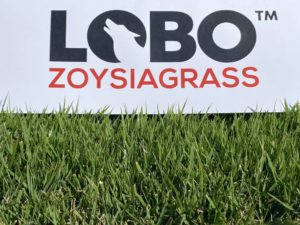
Lobo™ Zoysiagrass at the NCSPA Fall Field Day on Nov. 10, 2021.
“We were very excited about how aggressive this grass was from the get-go on roadside trials. But, when the USGA research came into play and we put it on the west coast in California and Arizona and it was retaining color really well, then we got way more excited,” she said. “When we started expanding it on sod farms, that was awesome. When you have experienced sod farmers like Chris Jones (Neuse River Turf) saying ‘This grass is so resilient, I can’t wait to have 100 acres of it”, or Hank Kerfoot (Modern Turf) telling you ‘I love this grass, I’m going to put it in at my house’… That was really special.”
If she had to pick one word to describe Lobo Zoysiagrass, she would call it ‘adaptive’ because she said you can mold it into what you want it to be. Based on trials, if a homeowner doesn’t want to irrigate, mow it often or fertilize it, Lobo will retain color and aggressively cover the ground. Also, if a homeowner wants a beautiful lawn and puts maintenance into it, it will become dense and lush.
“It’s very adaptive. I think it’s going to cover different niches in the industry and that is really interesting,” Milla-Lewis shared.
Participating sod farms are steadily increasing the production of Lobo and limited amounts of this zoysiagrass will be available for purchase in the summer of 2022. To read more about Lobo, click here.
Taking Chance on Turf
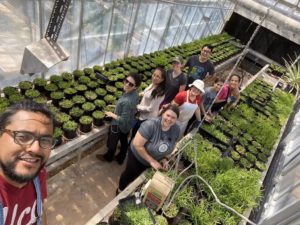
Milla- Lewis and team’s greenhouse party in February 2020.
Milla-Lewis encourages aspiring high schoolers that have a passion for outdoors or green space like she did to explore a career path in turfgrass because they might be pleasantly surprised. “Seek internships, seek experiences and seek people that work in the industry for advice and for just general information.”
There are many sectors, from golf, universities, sod farms, turfgrass outlets and more that students can look into if they’re interested in the industry.
“If you want to position yourself better to go after a career in this area, seek as much information as possible because a lot of time people realize years later they could have gone into something they were actually interested in. Look for that information and it’s not hard to find,” she concluded.
To learn more about Sod Solutions’ relationships with turfgrass breeders at land grant universities, download the Turfgrass Research: Year In Review by clicking here.
This article was written by Cecilia Brown.

